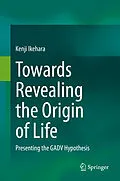The origin of life has been investigated by many researchers from various research fields, such as Geology, Geochemistry, Physics, Chemistry, Molecular Biology, Astronomy and so on. Nevertheless, the origin of life remains unsolved. One of the reasons for this could be attributed to the different approaches that researchers have used to understand the events that happened on the primitive Earth. The origins of the main three members of the fundamental life system, as gene, genetic code and protein, could be only separately understood with these approaches. Therefore, it is necessary to understand the origins of gene, the genetic code, tRNA, metabolism, cell structure and protein not separately but comprehensively under a common concept in order to understand the origin of life, because the six members are intimately related to each other.
In this monograph, the author offers a comprehensive hypothesis to explain the origin of life under a common concept. At the same time, the author offers the [GADV] hypothesis contrasting it with other current hypotheses and discusses the results of analyses of genes/proteins and the experimental data available in the exploration of the current knowledge in the field. This book is of interest for science students, researchers and the general public interested in the origin of life.
Autorentext
Kenji Ikehara received his degree in Industrial Chemistry from Kyoto University in 1968 and obtained his Ph.D. in 1976 at the section of Engineering of Kyoto University. He moved as research associate to Faculty of Science, the University of Tokyo, to associate professor, Nara Women's University and got promoted to full professor, Nara Women's University. He served as Director of the Faculty of Science, Nara Womens's University and as Director of the Nara Study Center of the Open University of Japan. He is also a fellow of the International Institute for Advanced Studies (IIAS) in Japan and Emeritus Professor of Nara Women's University. He served as Local Chair of International Conference, Origin 2014, which was held at Nara in 2014. He has published about 60 publications in international journals and contributed 3 chapters of international books as author, 1 book as author and 1 book as editor. He has participated in more than 100 congresses, presenting main, oral and poster communications in international and national congresses. His main research fields of interest are represented by the studies on origins of protein, genetic code, genes and life.
Klappentext
The origin of life has been investigated by many researchers from various research fields, such as Geology, Geochemistry, Physics, Chemistry, Molecular Biology, Astronomy and so on. Nevertheless, the origin of life remains unsolved. One of the reasons for this could be attributed to the different approaches that researchers have used to understand the events that happened on the primitive Earth. The origins of the main three members of the fundamental life system, as gene, genetic code and protein, could be only separately understood with these approaches. Therefore, it is necessary to understand the origins of gene, the genetic code, tRNA, metabolism, cell structure and protein not separately but comprehensively under a common concept in order to understand the origin of life, because the six members are intimately related to each other.
In this monograph, the author offers a comprehensive hypothesis to explain the origin of life under a common concept. At the same time, the author offers the [GADV] hypothesis contrasting it with other current hypotheses and discusses the results of analyses of genes/proteins and the experimental data available in the exploration of the current knowledge in the field. This book is of interest for science students, researchers and the general public interested in the origin of life.
Inhalt
